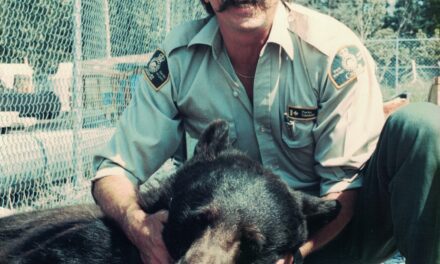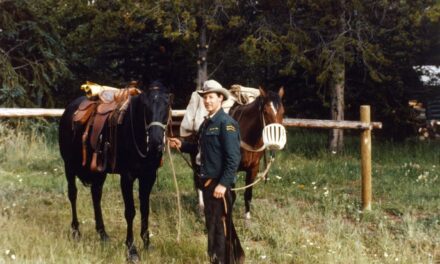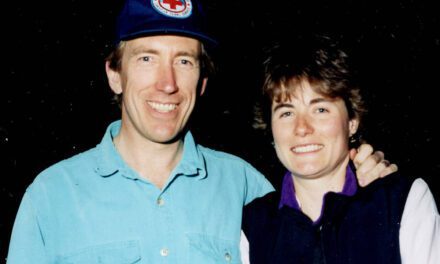

Another story on that. I don’t know if it was the same school or a different one. We were skiing the Mine Run. Cal Sime, we were all down in the creek bottom, Bostock Creek, waiting for Cal. He was a little late, partnering up with Bill Browne or something. Browne was a bit slow. Anyway Browne showed up so it was Cal’s turn to come down and get out of there so we could head out to the road. Cal hollered down and said, “What’s it like?” And we knew he was looking at this bump because he wanted to take a little air. So we all hollered back “Oh it’s good”. So he says, “Okay”. Well he comes flying off this bump. He’s about 40 feet up in the air and he’s right in the middle of Bostock Creek. The hang time is fantastic. But he stalls out at the apex of it, about 30 feet up and he just stops. And he kind of looks down at us and he’s not going forward and he just fell. Whoomp, right into the creek. Lucky the creek had ten feet of snow on it so he didn’t get wet. Just a big snowbank. The look on his face when he realized it was dead flat and he had no forward speed, and he was just going to fall straight down was priceless. I’ll never forget the look on his face.
SH: School stories seem popular. Would you like to talk about any other school stories? I’ve had lots of Eight Pass stories.
Dave: Well on the last one I think the temperature on that one was -36 Celcius when we left. We were all sitting around thinking we were going to die. Nobody died but I think we came close. (Tape 09:07) Cooking pork chops on shovels and Willi coming around and saying, “Leave me your grease.” so he could soak the grease up with his bread.
Dave: I went on a Fuhrmann school. We went up to the Neil Cogan Hut. We climbed up there. Fuhrmann had flown all the food in. The helicopter had been in the week previous and he’d dropped some food off. I’d been on a Furhmann school or two before that so I knew what to expect with food. Especially if the food was in there for a week. It was all cans. So I’d taken along some cayenne pepper, salt and pepper and a few other spices just to jazz things up a little bit to make it a little bit more edible, because usually those meals ended up with everything thrown in a big pot, stirred and then you dipped your cup in the pot and that was that. So it could be, well no it was, it was canned chickens, like a whole chicken in a quart can, one of those deals. Off goes the top and this gelatinous blob falls out into the pot. Same thing with a big cooked ham, canned. Everything was in a can. So we climbed up there and that’s what was waiting for us for food. And everyone was grumbling. So I pulled out all these spices that I had. That helped and made it palatable anyways. We did a little bit of climbing, but it turned out the main reason we were there was to build a new outhouse for the Alpine Club. So we spent a full day hauling rocks and building the foundation and built a nice outhouse together. A few people grumbled, figured we should be climbing instead of building an outhouse. That was the way Fuhrmann did things. He was an interesting guy, completely different than Willi. Willi was a hands on kind of a guy and Fuhrmann was wheeler dealer, talker kind of guy. (End of Section: Tape 12:06)
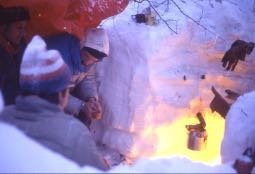
Dave, Al Stendie and ? in a snow cave while on an 8-pass course. Photo courtesy of Terry Damm.
Part Five: 11:44 am
SH: Can you tell me about any rescue/wildlife/enforcement stories that stick out in your memory? Dave is going to tell some stories about people he worked with in Jasper.
When I was in the Smokey District that first summer I met Buster Duncan. He was a local outfitter from Valemount. He always did outfitting every summer for the Sierra Club, and the Sierra Club went somewhere in Jasper. So, on my trip in I was going up the Berg Lake hill, went by Berg Lake and Buster was camped there with his wife Margi and his son Rex. Rex would have been about 14 at the time I guess. I rode by and first time I’d met them. Buster is a big gregarious, smiley kind of guy and invited me to have a cup of coffee with them. So I did, and he said, “Why don’t you come back later and have supper with us?” The cabin is about two miles down so I said okay, and I went back and had supper with them and rode back in the dark. As I was leaving Buster said “You wouldn’t have a couple of old horseshoes lying around with some nails, would you?” I said there was quite a pile in the shed.
So he said, “Well could you put a couple of old shoes, and some nails and a hammer out, and I’ll come by in the morning, I’ve got a couple of loose shoes”. So about 10 o’clock, I’m in the cabin having coffee. All of a sudden there’s this hooting and hollering and thundering hooves and around the cabin goes this string of pack horses. They’re all loose, all tied off. And Buster, Margi and Rex are at a full gallop chasing these loose pack horses around, and around Adolphus cabin like a whirlwind. So Buster comes flying off this horse at a gallop. Digs his heels in and stops, and say’s “Hi, how’re you doing?” These horses are still milling around. He grabs this shoe and a mouthful of nails and a hammer. He’s running around the yard trying to catch galloping, loose horses. Finally he sees the one he wants and takes a lunge at it and grabs the halter shank. He jerks him to a stop and snubs it up to a tree. Next thing you know his foot’s up in the air, and barefoot and he just slaps this unknown shoe, not shaped or anything for that horse and nails it on with a hammer, twists the nail heads over, gives it a quick tap to clinch him, and he did about three like that in about three minutes. He says, “Thanks a lot” and down the trail they were gone. That was my first introduction to Buster Duncan. Just a wild man. Anyway, his one piece of advice on the backcountry was just go with it, don’t fight it. Whatever happens just roll with it. don’t try to cram your agenda into it. Things change and to try and force things you’re going to get into trouble. Don’t force things. That was good advice for all kinds of things really. With horses and being by yourself and having to watch every move you made when there was nobody to help you out. It was good advice. (Tape 04:22)
The other Jasper story I’ve got. Unfortunately, when I was in Jasper, Neil Cogan was killed in the backcountry in Banff above Douglas Lake. Nobody was there and he was found later. It was felt pretty strongly that he was cow kicked in the kidneys and died of internal injuries. Anyhow, the horse that he had, that did that was a packhorse named Miles,. (The gelding originally was named Gunner). He was a black thoroughbred, that came out of the RCMP stock from Fort Walsh and had been given to the Ya Ha Tinda, Parks Canada, years ago. At that time there was quite a few of those black thoroughbreds around. Most of them were pretty touchy. Anyway Miles, they didn’t want him in Banff, so Miles came to Jasper. I was in the Tonquin Valley that summer and ended up with Miles. I didn’t have any trouble with him but he was one of the touchier horses I’ve ever worked with as far as short fuse.
The other Jasper story, was when I was in Lake Louise but I went back to Jasper for a climbing school. It was one of Willi’s climbing schools, to climb Mount Robson. At that point he’d had two failed trips Mount Robson; he failed to get up because of weather and various things. So this group was put together so Gerry Israelson, Diane Volkers, Chris Worobets came from Banff. There was 9 of us in total. There was Willi and Brian Wallace, Darro Stinson, and one of the RCMP. Anyway we climbed it. Willi was really keen on getting a group of wardens to the top of Mount Robson. We climbed up the first day to the hut and then we climbed beyond the hut to Little Robson and camped that night. On the second day we went for the summit and it was fogged in completely. I’ll never forget climbing, I was on a rope with Gerry leading, Diane Volkers and myself and in this fog, we got off route, unbeknownst to us because of the fog. We got into these things called the gargoyles. The fog cleared a little bit and you could look between our legs, we were front pointing going up the slope, and you could look between your legs and see Kinney Lake, about 9000 feet below us. And we realized when the fog cleared a little bit that we were in the gargoyles, too far to the left. So we beat it over to the main snow face, got out of that and into the icefield proper instead of those chutes in the seracs. So, once we got onto the icefield, the next challenge over the bergschrund and now we are on the ice pack on the peak. We then made it up to the summit. The fog cleared a little bit and we got a little bit of a look around. I’ll never forget when we were all on the top, a Lear jet flew by. Not far away, somebody taking a look at the peak. It was one of those surreal moments. You’d been busting your gut for a couple of days to get to where you were and then a guy flies by in a Lear jet. (End tape 08:19)
Gerry was out front leading to the summit and he’s angling towards the summit. It’s quite a steep slope, 45 degrees or so, and we’re angling across it. Because it is now afternoon it is getting quite warm. The fog has trapped the heat in and the snow has warmed up really quick. Gerry is picking the odd snowball up and throwing it ahead and he is starting to get point releases off those snowballs. And those isothermal slides, they are gathering steam and getting bigger and bigger and going down the southwest face of Mount Robson. And it’s a long way down there. Finally, Gerry stops because he doesn’t like what he’s seeing and turns and talks to Diane and I and said “I don’t like it”. As he’s talking to us the two ropes behind catch up and Willi is on the last rope, and we hear from way in the back, Willi’s big voice, “Israelson what are you doing?” Willi hollers back, I don’t like it, it’s not good.” There’s silence. And then we hear Willi again “Gerry what are you going to do?” And Gerry said “I don’t really know what to do here.” And Willi hollers back, “What you going to do? Go back down, or stand there til you fall off, or just go?” So, Gerry just went, and everything was fine and we made it to the summit. But that phrase “Just go” became a catch phrase in the Warden Service for many years after. Anytime anybody was in a tight spot or didn’t know what to do or what they should do next, if there was somebody else around they’d say “Just go”.
(Gerry arrived as we were finishing our coffee and added that extra line about go back down….)
September 16 – 10:08 am – another story
This was the same day as a tornado in Edmonton that killed 26 people. I forgot what year that was, in the 90s sometime. That day we rode from Scotch Camp up to Divide and my wife Angie was with me. As we rode up to Divide around 11 o’clock or so, it got really strange out there. The sky got dark but it had kind of a grey greeny, coppery colour, a weird look. I’d never seen a sky like that. It got so dark that you almost had to have lights on cars if you were in a car. But we saw a black bear running through the bush as we were getting near timberline, and five minutes after that we saw a black wolf running through the trees. There’s all the wildlife doing strange things, just running for no reason. And we ride along and then we drop down into Divide Creek to cross over to the cabin. There’s a lot of willows there. The willows are ten feet high and quite thick and as you went through the creek you basically just drop through a hole, notch in the willows. As I did that, and my horse is half way across the creek a big grizzly stands up and he is not 15 feet away. He is standing on his hind legs so we’re eyeball to eyeball at about 15 feet. He just looks at us, the horses got a little tense, but didn’t do anything. And he just dropped down on his feet and ran up the creek, and was gone, and that’s the last we saw of him. Anyhow, we arrived at Divide at radio call we found out that the strange day, Edmonton had a tornado and 26 people had been killed. End 2:41
Part 5 12:12 pm
SH: Would you like to talk about how the Warden Service changed over the years?
Dave: In the mid 90s Parks took a turn and the big thing – it was the start of the whole downfall of the Warden Service to the point where we are now. It was privatization. The powers that be in Ottawa felt the best way to run things was to privatize everything; from highway maintenance to carpentry service, campgrounds, garbage facilities, everything was going to be cut.
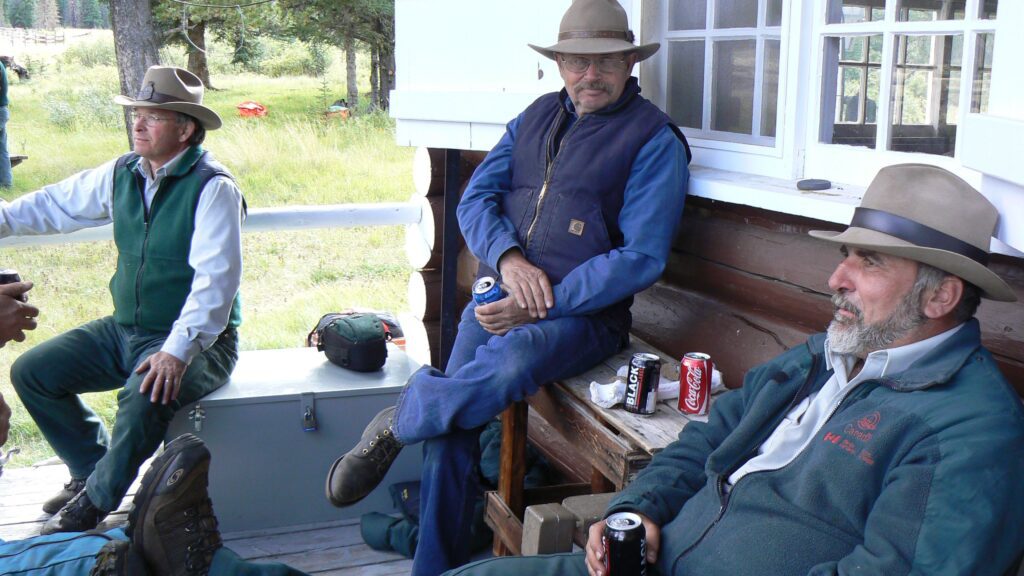
Dave, Gord Anderson and Terry Winkler at Scotch Camp, September 2009.
There was talk of streamlining the Warden Service and having it fall under different managers. Parks went through a period of extreme navel gazing; trying to figure out who they were, what they were doing and why. For people in the Warden Service it seemed crystal clear what we were doing here, because people in the Warden Service in a lot of ways felt they were the custodians of the park ideal and why parks were there. They represented the best interest of the parks and tried to maintain the integrity of national parks. Most wardens felt that it was their responsibility to make sure that continued. In whatever you ended up doing, that particular job or the specialty within that, everybody had that common kind of feeling, about why they were there and what they were trying to accomplish. And if it wasn’t for them, things could go off the rails and go sideways. Well they started to. And I’ll never forget this internal navel gazing. They hired a consultant, a well- known guy from Canmore, Bob Sandford. Sanford became like a svengali for upper management. That was the beginning of the end for us. If you look back, ten or fifteen years of hindsight you can pinpoint it. It was right there, when that nonsense started. Things started to unravel. (Tape 03:09)
Things got worse from that. One of the things that fell out of the evolution of the Warden Service was specialization. I don’t know where it started first. There were some strong people, well-intentioned people. Cliff White … Cliff had gone on and got a higher education and he came back with his newfound knowledge of fire ecology and wildlife management ideas and that whole end of the shop became a specialized group of people. They started hiring biologists to manage different aspects of resource management. Well meaning, productive and it improved how we managed things. There was no question it did, it was a real leap forward. At the same time public safety was becoming more specialized. The leadership of the public safety program had gone from the direct hands on leadership of Willi Pfisterer in Jasper, who actually led rescues, led wardens and brought them along. Then Willi moved on and by this time there were key wardens in the public safety field that were becoming full mountain guides, with another group behind them at the assistant guide level, who carried on and became full guides themselves. So the public safety program became quite specialized and evolved to the point where people that were trained as guides did most of the work. It was only on bigger events, like searches and avalanches, where you needed more manpower on the ground, where the rest of the Warden Service might be brought in. (Tape 05:22)
That specialization, it elevated the service to the public no doubt. Then at the same time the law enforcement people, tried to elevate their program as well, and become more professional, do a better job. So, in the late 90s, part of that conversation, some of the people within that law enforcement group felt very strongly about needing to be armed. I think at that point, arming of the wardens was the last nail in the coffin. It was a done deal then. It was only a matter of time before the whole thing unraveled, and it did. There was a fellow came out from Ottawa, Tom Lee. He came out and talked to us one day at the Banff Warden Office. He didn’t think anybody needed guns because he’d been a seasonal park ranger in Algonquin Provincial Park in Ontario. He had a uniform, which was a green t-shirt and he didn’t need a gun to do his job, so he didn’t know why anybody out here thought they needed one. And I realized after listening to him talk, if he’s our leader, and that’s his attitude, there’s only one place this can go.
I remember talking to Bill Hunt, who at that time had come on from Jasper as a Warden in Banff. Bill had aspirations of going farther up the pole and he took a job with Visitor Services in Lake Louise. One day I was going through Lake Louise and I stopped in to say hello to Bill. This was at the height of the discussions about arming. He said he’d been to Ottawa for a uniform committee meeting and he said, “You guys need to realize that everybody in senior management in Ottawa thinks every warden out west is wearing a Doug Martin mask. You are all the same. You’ve all been painted with the same brush. You mention a Park Warden from Western Canada, and they are all the same.” And that’s when I realized for sure, we were screwed now. It might sound harsh to lay it at Doug’s feet, because he was just the point person for the Union. He elected himself the point person because he was a union guy. So he championed that cause and pushed it and pushed it to the point where it was the last straw… it was the end of it. By this time there were new Chief Wardens being put in place and you could tell the Chief Wardens were being hand-picked from Ottawa, for not maybe being the strongest Chief Wardens in the style of Bob Haney. As far as I’m concerned Bob Haney was the last Chief Park Warden we had. (End of Section: Tape 10:08)
Section 6: Tape 12:32 pm
Dave: People who would be compliant and not push back on the direction Ottawa wanted to go. I think by this time Ottawa had decided that they would dismantle the Warden Service, because it was getting too powerful. Too many strong personalities, too many programs that were successful. It was too much the identity of Parks Canada, and there were senior managers that resented that. They didn’t like that. It didn’t fit into their perception of how the hierarchy worked. So, I think the success of the Warden Service was what ended up doing ourselves in, we were just good, too good at too many things, and perceived as too strong, too powerful, and the firearms thing, that was the last straw.
SH: I think there was a bit of an elitist reputation
Dave: I know they felt the wardens were elitists, but that wasn’t elitism, that was esprit de corps. It’s absolutely is … you end up, whatever you’re doing, you end up on a rescue together, you got your neck stuck out a little ways. You’d end up doing things that were a little dicey sometimes and everybody had each other’s back. That developed that camaraderie, that esprit de corps, and strengthened it every time something like that went on. And it wasn’t just rescues, it was all kinds of stuff. We were all there trying to accomplish a common goal, common good. The people want to call it elitism, they can call it that, but the people who were calling it elitism didn’t experience what we were experiencing. And if they had, they wouldn’t call it elitism. (End Tape 03:00)
Section 7: 12:35 pm
SH: What about the Warden Service was important to you?
Dave: Very quickly, coming on in Jasper you realized what you were doing there and why everyone else was there. It was a special piece of Canada, all of the parks. You really felt that it was up to you, you were part of a group of people that were trying to maintain that. Being out in the mountains, when you are out on horseback, in the bush for a few days, you can start to see the long picture pretty quick. You’re not stuck around pavement, or in offices or in a bunch of people where the here and now is right in front of your face. When you’re riding down the trail for 6-7 hours by yourself, in country that is virtually unchanged, you realize that you have to, somebody has to protect that, it’s important. It’s important as part of Canada, it’s important to our identity as a country that these places exist. And you look around and you see ski hills and certain developments, and people wanting to build hotels. And you realize pretty quick that if somebody is not standing there, people will to chip away at it, the developers and people that want to make a buck off it. Somebody had to do something. It was very small, protecting wildlife, people’s camping experience. Whether people cut down a tree in the campground or were making too much noise and disturbing someone else and ruining their experience, or somebody is in trouble. You were there to maintain the park, and hopefully people would have a good experience. In the overall picture, in the 30 plus year picture, that was satisfying, to play some small part in maintaining that. There were other moments with rescue work where you saw results right in front of your eyes, whether somebody lived or died. You saw things like that happen. (Tape 03:01)
SH: Are there any legends or stories associated with the Warden Service that you can share? Is there anyone from the Service that stands out in your mind?
Dave: Oh ya, I’ve talked about a few. Clair, Gord Irwin, real strong personalities, strong individuals.
Gord Irwin skidded me up the North Face of Mount Fay, up the Chouinard Route. I was never a real strong mountain climber, but Gord managed to skid me up that thing. That was one memorable experience we shared. Tim Auger … I liked Tim’s calm, quiet approach to everything. His dry twisted sense of humor. Understated, soft spoken, and extremely capable.
SH: Do you have a Tim story you can think of?
Dave: Remember that guy who fell into Bow River. He was in the river, fell off the viewpoint. Anyway, he fell down the slabs and broke his pelvis.
SH: Oh at Surprise Corner.
Dave: Yes, anyways, there he is, people call it in. There’s this guy in the water clinging to the slabs. It’s about 60 to 65 degree slabs when you’re in the water. Quite smooth. This guy is just hanging on, screaming. So, I just happened to be right there in the office so I went with Tim. We went out there and Tim took one look and hollered at this guy, and realized that he was in bad shape, that he wasn’t going to last much longer being in that cold water and he was injured. He was going to go over Bow Falls pretty quick. So Tim just grabbed his rope and threw a hitch around the bumper on his truck, and he said “Here’ belay me.” So I belayed him off the bumper hitch of his truck. He went down the slabs and he grabbed this guy by his shirt color. The guy had a broken pelvis. And once he grabbed him by the shirt collar he managed to put a sling under his arms. He was still in bad shape but at least he wasn’t going over Bow Falls. Once he got him secured, some more people showed up we managed to send a stretcher down and moved him into a stretcher. It was one of those things where you had to do it now, right now. (Tape 06:56)
